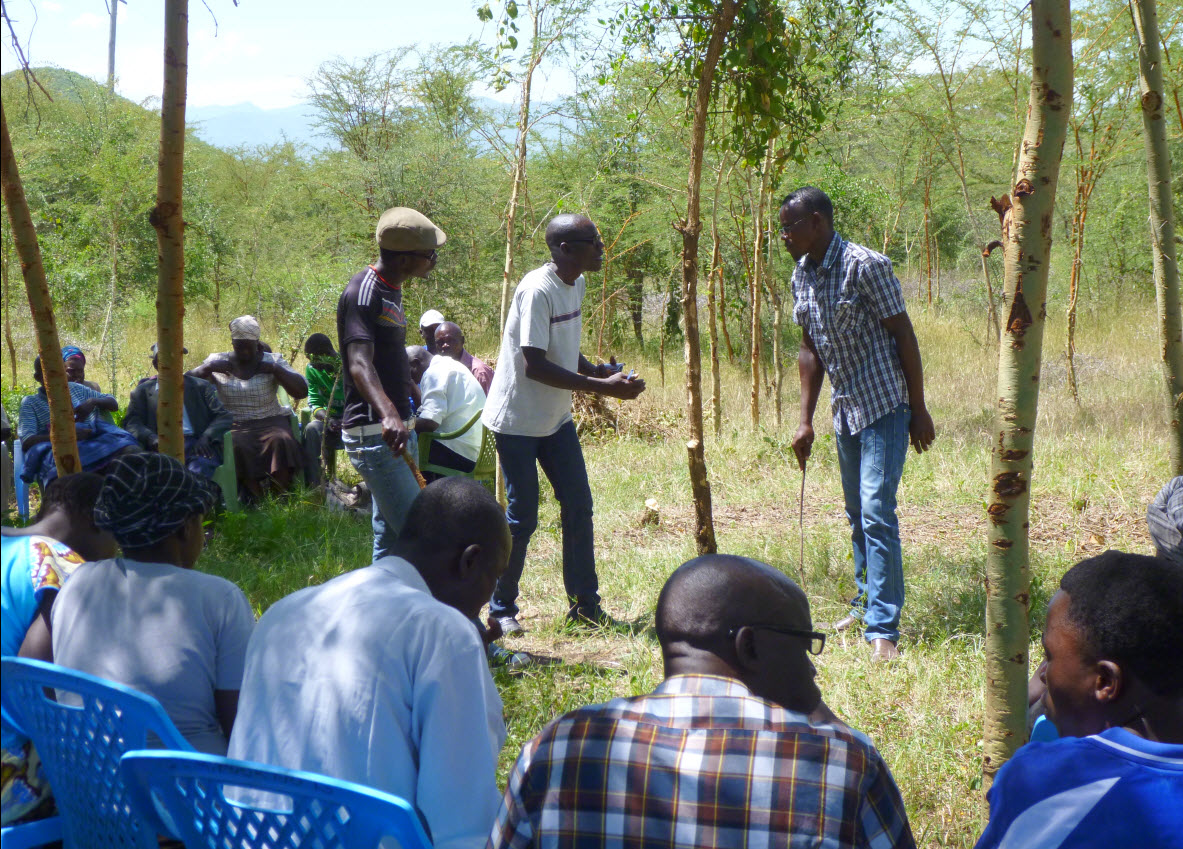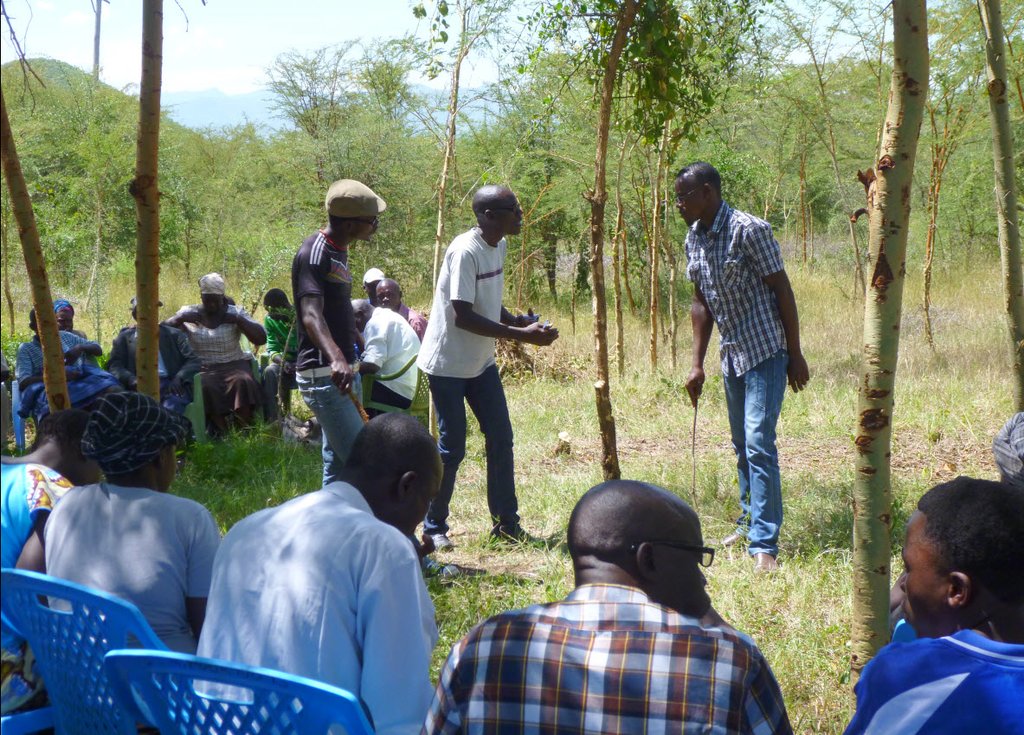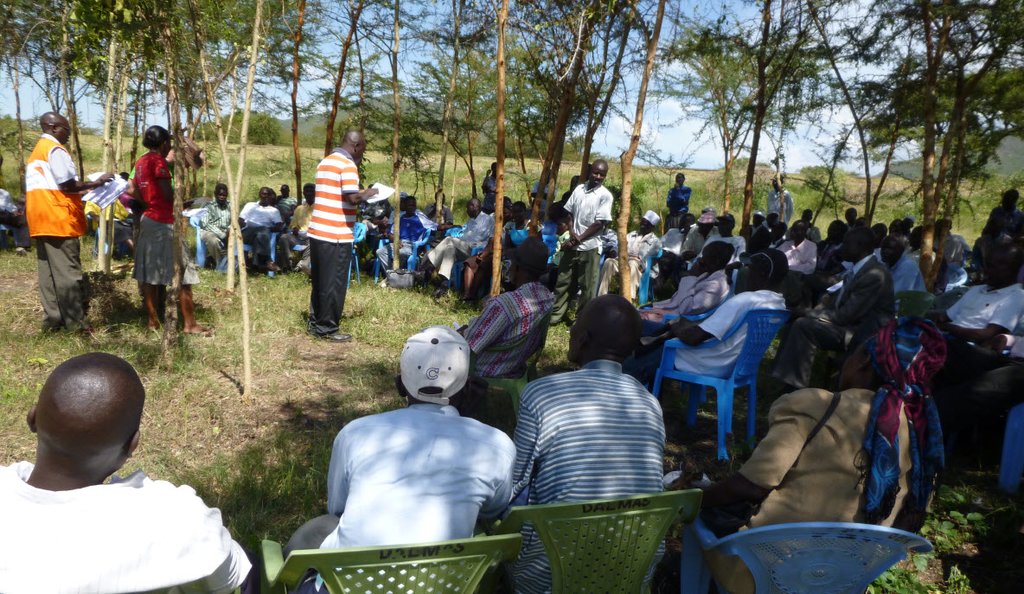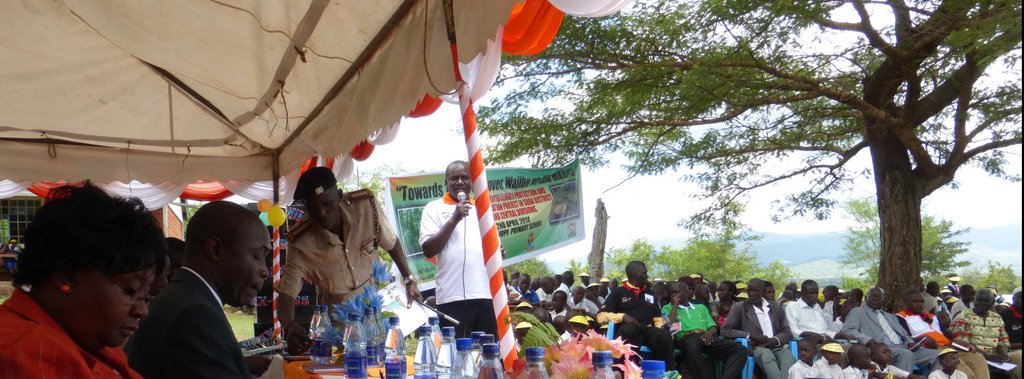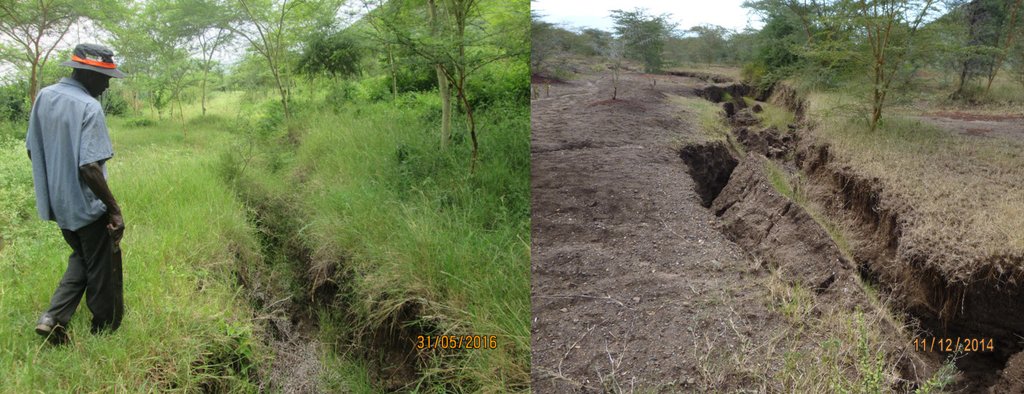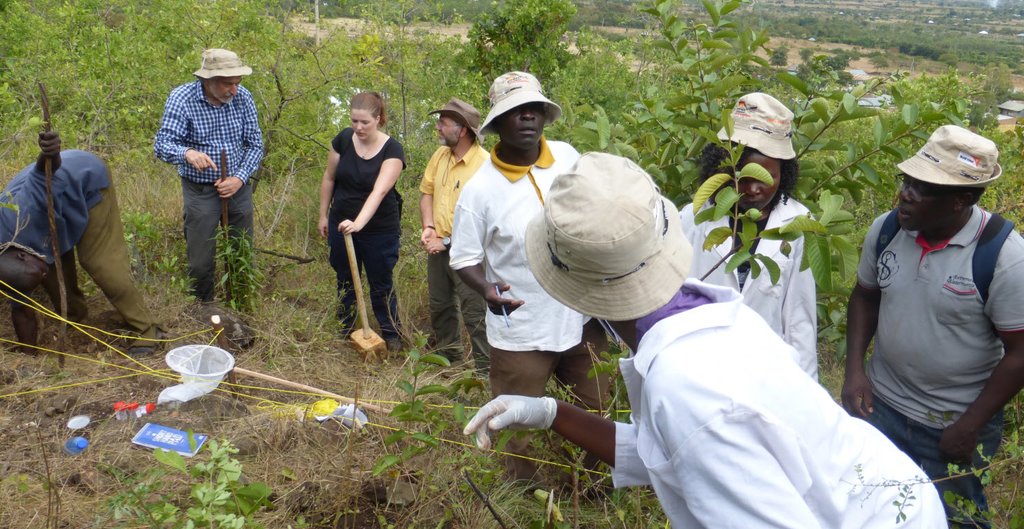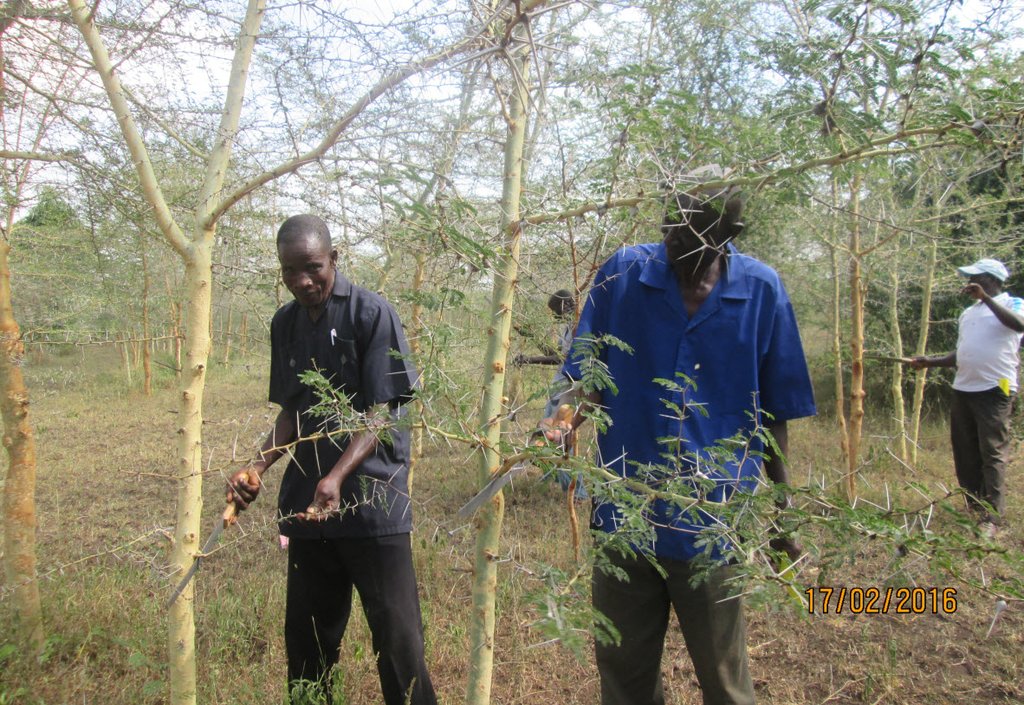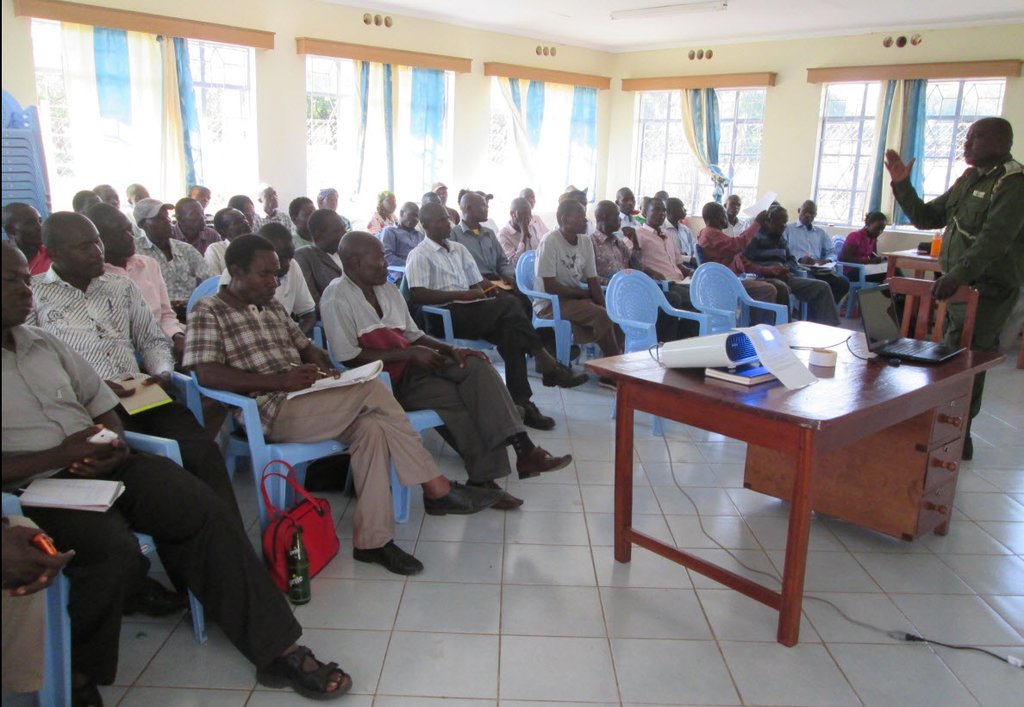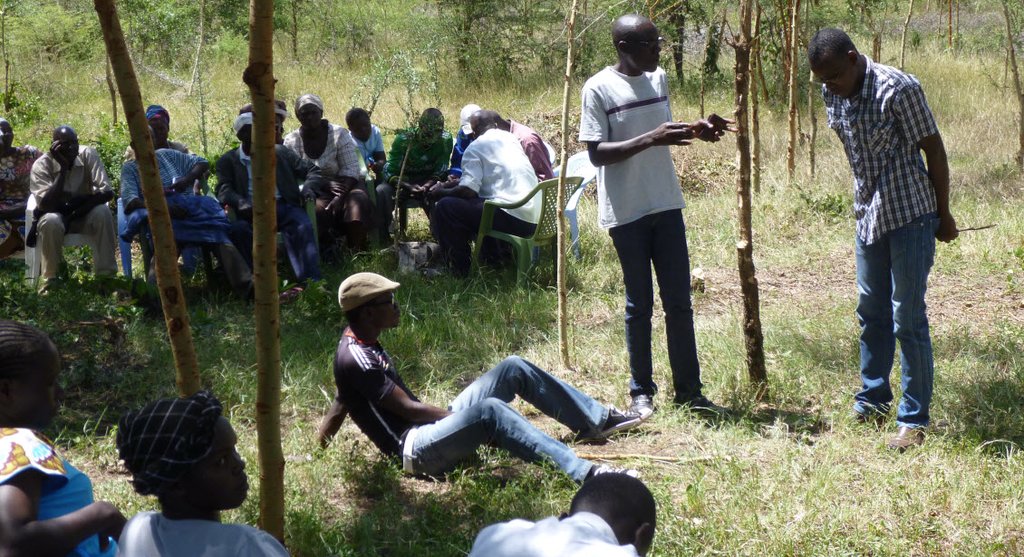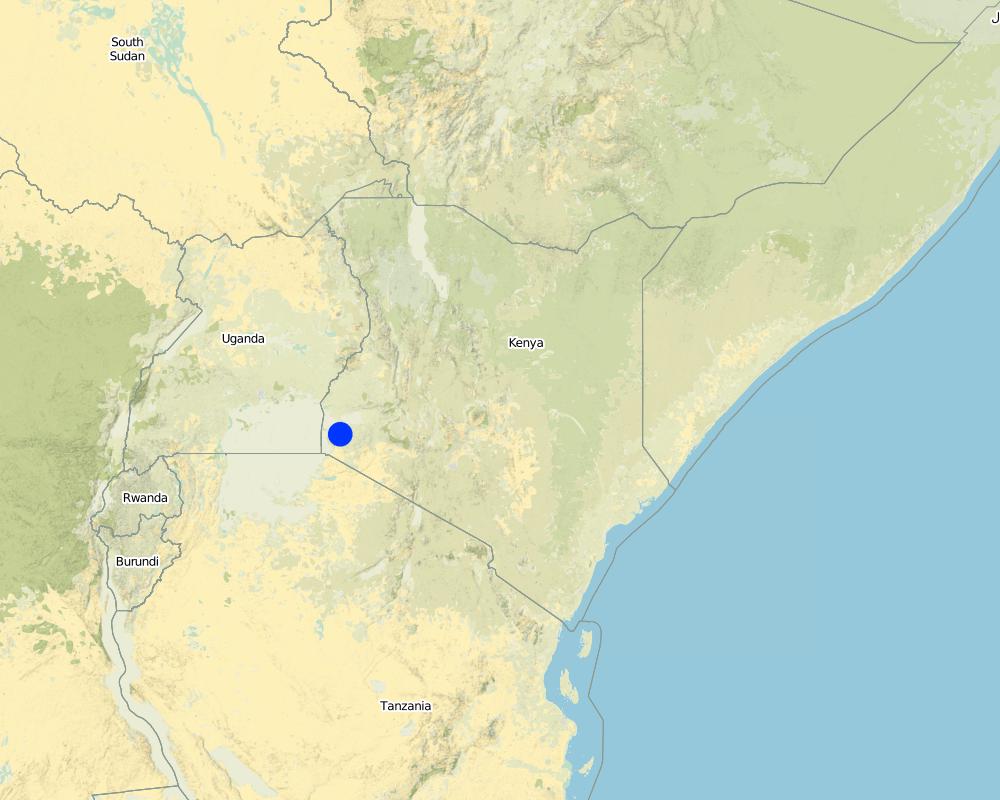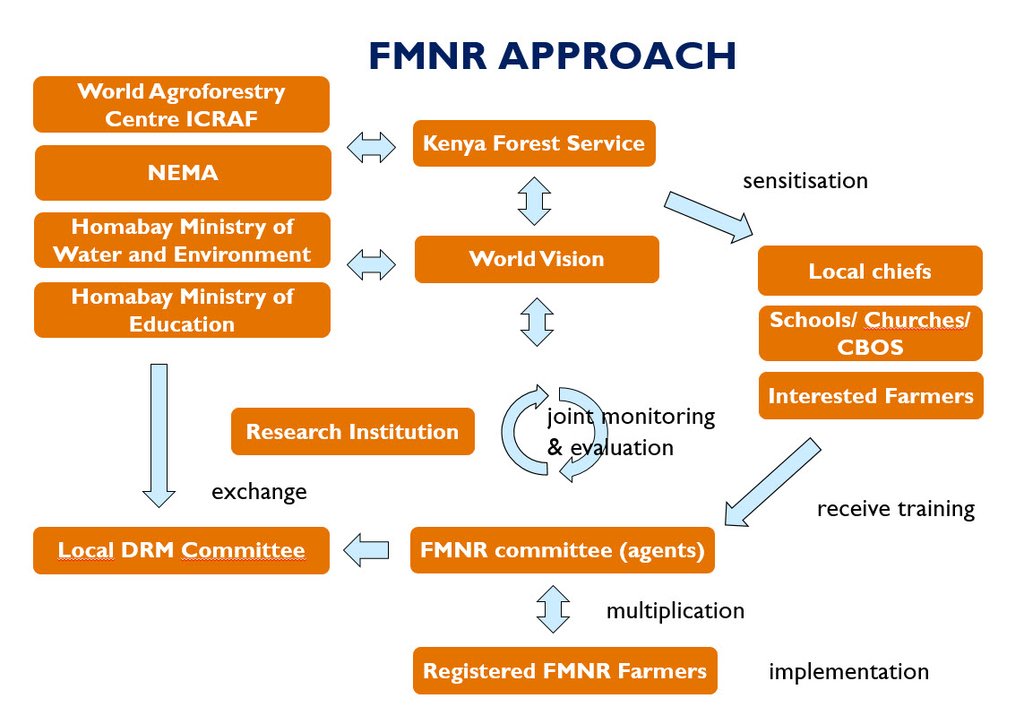FMNR implementation approach [Кения]
- Создание:
- Обновить:
- Составитель: Thomas Kalytta
- Редактор: Irene Ojuok
- Рецензенты: Alexandra Gavilano, Deborah Niggli, Hanspeter Liniger, Donia Mühlematter
FMNR nyale
approaches_733 - Кения
Просмотреть разделы
Развернуть все Свернуть все1. Общая информация
1.2 Контактные данные специалистов и организаций, участвующих в описании и оценке Подхода
Ответственный (-ые) специалист (-ы)
Специалист по УЗП:
Ojuok Irene
+254725859689
Irene_Ojuok@wvi.org
World Vision
Lambwe Valley ADP Office, Homabay, Kenya
Специалист по УЗП:
Kalytta Thomas
0041445101593
thomas_kalytta@wvi.org
World Vision
Kriesbachstrasse 30, 8600 Dübendorf, Switzerland
Швейцария
землепользователь:
Sijenyi Onyiego William
0727369635 / 708297048
n/a
Obanda Environmental project Mbita Sub County, Dr Tom Mboya Okeyos Farm along Mbita Homabay Road. The site is by the road side
Название проекта, содействовавшего документированию/оценке Подхода (если применимо)
Book project: where people and their land are safer - A Compendium of Good Practices in Disaster Risk Reduction (DRR) (where people and their land are safer)Название организации (-ий), содействовавших документированию/оценке Подхода (если применимо)
World Vision (World Vision) - Швейцария1.3 Условия, регламентирующие использование собранных ВОКАТ данных
Когда были собраны данные (на местах)?
28/11/2016
Составитель и ответственный/-ые специалист(-ы) согласны с условиями, регламентирующими использование собранных ВОКАТ данных:
Да
1.4 Ссылка (-и) на Анкету (-ы) по Технологиям УЗП
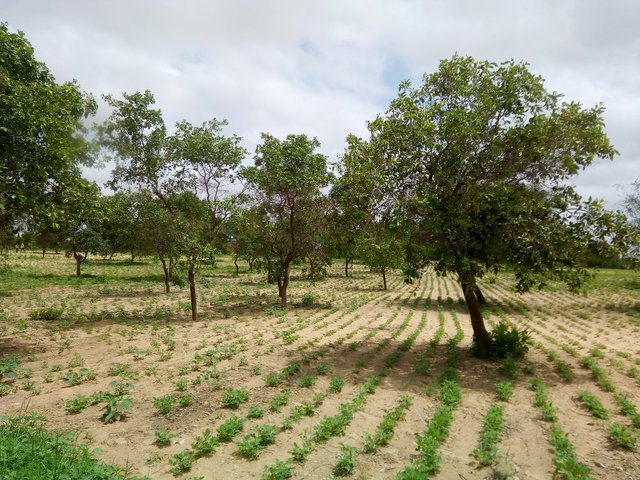
Régénération Naturelle Assistée (RNA) [Сенегал]
None
- Составитель: Diaminatou SANOGO
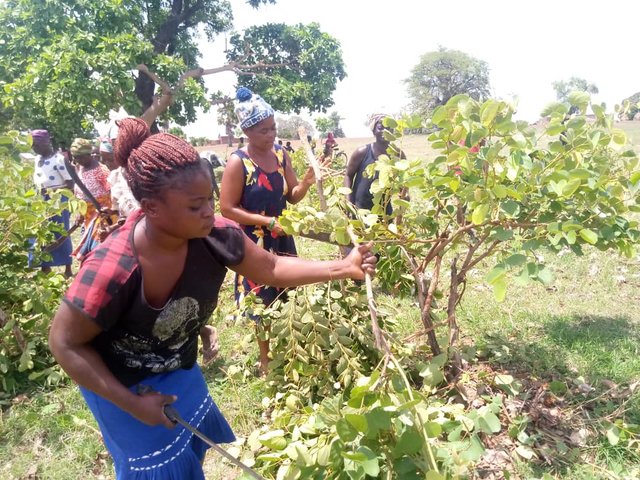
Farmer Managed Natural Regeneration(FMNR) [Гана]
Farmer Managed Natural Regeneration (FMNR) comprises a set of practices used by farmers to encourage the growth of native trees on agricultural land by systematically allowing regeneration and managing trees and shrubs from tree stumps, roots and seeds.
- Составитель: Joshua Adombire
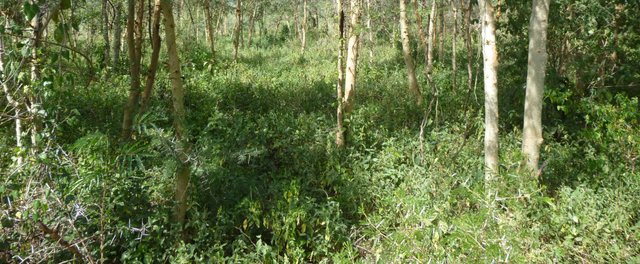
Farmer Managed Natural Regeneration (FMNR) [Кения]
Farmer Managed Natural Regeneration (FMNR) is a proven SLM Technology to restore degraded wasteland and improve depleted farmland. The farmer regu- lates and facilitates the re-growth of existing trees stumps, or self-sown seeds in the soil, and thus promotes soil fertility and through better ground cover, increases protection from runoff …
- Составитель: Thomas Kalytta
2. Описание Подхода УЗП
2.1 Краткое описание Подхода
After consultations with local stakeholders, experts (from NEMA, ICRAF, KFS, Wildlife Kenya) and Homabay County Government representatives the FMNR approach is being introduced by World Vision through a public funded project. The aim of the approach is to promote FMNR and sustainable land and natural resource management through disseminating the basic idea of regenerating trees.
2.2 Подробное описание Подхода
Подробное описание Подхода:
The approach follows the basic principles of the of Training Trainers ToT (transfer of technology) concept i.e. key stakeholders and agents are trained to pass their knowledge on to others. Through a multi-stakeholder inception workshop all local stakeholders learn about the FMNR technology, its advantages and impacts. Representatives of the county and the national government are invited in order to get their support. Technical experts in agriculture are represented as well.
The Kenya Forest Service (KFS) and World Vision (WV) are the main actors in sensitising the local chiefs, school head teachers, CBOs, self-help groups, farmers' associations and individual farmers about FMNR, Disaster Risk Reduction and other topics. As a result farmers, teachers, schools management committee and CBO members register for the FMNR training, which is also carried out by KFS and WV. Selected farmers (those who are early adopters) are chosen as FMNR agents.
The registered FMNR practitioners (farmers, CBO members, school children, etc.) have to set aside a plot for FMNR application. They implement the technology. Each administrative unit (ward) establishes one FMNR committee under the lead of the local chief. The FMNR committee members (agents) are responsible for further dissemination for training and monitoring of the activities and maintaining the demonstration sites. They also organise exchange visits. They regularly report back to World Vision Development Facilitators. New FMNR farmers register with the committees. Research institutions (e.g. Maseno University) conduct studies to follow-up assumptions and to document change. The Community Disaster Management group is influenced by the FMNR committee and the County administration with regard to erosion control measures and gully restoration.The implementation is jointly monitored by the key stakeholders and documented by World Vision.
2.3 Фотографии, иллюстрирующие Подход
Общие замечания к фотографиям:
Most of the training is done on site which practical demonstrations. 6 fenced demonstration sites and other show cases serve as pilots for the whole community.
2.4 Видеоматериалы по применению Подхода
Комментарий, краткое описание:
A majority of East Africa community relies on agriculture and livestock production as the main source of livelihood yet these sources are experiencing challenges including environmental degradation and climate change. A number of interventions have been promoted at household level. The video teaches about the approach applied in a couple of countries in East Africa.
Дата:
09/04/2016
Место:
Kenya, Uganda, Tanzania
Автор съемки:
World Vision
Комментарий, краткое описание:
Video in German language
Im Kampf gegen die Dürre hat Tony Rinaudo eine simple Methode entwickelt. Anstatt Bäume zu pflanzen, greift er zur Schere und stutzt die Pflanzen, die bereits wachsen. Mit sensationellem Erfolg.
The quality is better on youtube: www.youtube.com/watch?v=tgdcbxE-OQo
Дата:
02/09/2016
Место:
Tanzania
Автор съемки:
World Vision
2.5 Страна/ регион/ место, где применялся Подход
Страна:
Кения
Административная единица (Район/Область):
Hombay County
Более точная привязка места:
Suba and Mbita Sub-Counties
Комментарии:
One major demostration site is indicated only, kindly refer to the FMNR technology for more sites.
Map
×2.6 Даты начала и окончания реализации Подхода
Год начала реализации:
2014
Год окончания (Если Подход больше не применяется):
2017
Комментарии:
The approach of the FMNR technology was introduced by World Vision through a public funded project on climate protection and natural resource management. It received the “Total Kenya Eco Challenge Award” in 2016. The introduction was done through the following steps. The project staff were trained on the concept after which they trained Government staff in forestry, education and agriculture department including chiefs and assistant chief who were to turn out to be the entry point/ ambassadors for the concept. Intense trainings, awareness campaigns, practical demonstrations, consultative meetings and observations were conducted. Till now more than 300 hectares of degraded land was reclaimed through FMNR and over 1000 farmers adopted the practice already.
2.7 Тип Подхода
- в рамках проекта/ программы
2.8 Каковы цели/ задачи Подхода
The main objective of the approach is to promote FMNR and other natural resource management practices including agroforestry, crop diversification, sustainable rural energy sources and rehabilitation of highly degraded areas. It is also to utilise environmental education to advise on disaster risk reduction in order to increase the resilience of the target population against adverse effects of climate change and natural disasters.
2.9 Условия содействующие применению Технологии/ Технологий в рамках Подхода или затрудняющие его
Социальные/ культурные/ религиозные нормы и ценности
- содействуют
enabling factors are the medicinal value of trees, herbs, the importance of places for worship and local rituals,
- затрудняют
livestock and fire put the FMNR sites at risk, fire is sparked on hill tops to attract rain. Some neighbouring farmers also complain about the return of biodiversity especially of monkeys and snakes. Some people still maintain old traditions (clean agriculture) hindering women participating in meetings, from planting trees or working on trees in their homestead. These people are more resistant to new ideas and approaches.
Наличие/ доступность финансовых ресурсов и услуг
- содействуют
natural materials can be used (wood, fruits, pods and grass) or sold, money for fire wood can be saved
Институциональные условия
- содействуют
some schools have surplus land which is ideal for FMNR and tree planting,
- затрудняют
sometimes even members of the school management board send their cows for grazing that hampers the FMNR attempts of the school children
Сотрудничество/ координация действий
- содействуют
most partners are very supportive towards FMNR
Нормативно-правовая база (землевладение, права на земле- и водопользование)
- затрудняют
a clear legal framework is lacking, the ownership of "wasteland" needs to be clear otherwise everybody tries to make benefit out of it (over grazing, charcoal burning)
Программные документы/ руководящие установки
- содействуют
the Kenyan Government has issued a policy that 10% of the land should be covered by forest
Управление земельными ресурсами (принятие решений, осуществление и контроль за выполнением)
- затрудняют
young farmers complain that they have not the full rights over the family land, so they can only go for FMNR if the fathers agree. As young farmers who have not yet inherited land from their fathers according to customary laws still don’t own land which they could have long term plans. This hinders them from immediate adoption of FMNR due to land ownership rights. Mostly young men are given their share of land at about 40years. Hence this delays in uptake.
Осведомленность в области УЗП, доступность технической поддержки
- содействуют
the Kenyan Forest Service officers were very supportive
Рынки (для приобретения материалов и услуг, продажи продукции) и цены
- содействуют
access to local markets are an advantage to sell the farm products e.g. honey is on demand, firewood, crop harvest, inputs are not very much needed apart from standard farming tool and strong gloves
Объем работ, доступность рабочей силы
- затрудняют
FMNR can create more work but the longer-term benefits are obvious. However, lazy people who are not patient will not appear to training sessions because they might not have understood the benefits of the technology.
3. Участие и распределение ролей заинтересованных сторон
3.1 Заинтересованные стороны, участвующие в реализации Подхода и их роли
- местные землепользователи/ местные сообщества
small holder farmers, registered FMNR agents, DRR committees
The stakeholders were sensitised, received training, spread the message to peers and take part of the joint monitoring (agents)
- организации местных сообществ
CBO and self-help groups, religious leaders (Churches), local NGOs
took part in the training, mobilised their members to adopt the practice, make links to other stakeholders,
- эксперты по УЗП/ сельскому хозяйству
agricultural extension officers (weak), Kenya Forest Service officers
the KFS officers are involved in the technical training, while the farmers have to go and access the extension officers in the towns to receive their advice
- ученые-исследователи
Maseno University
measure the tree density, the biodiversity change on the demonstration sites
- учителя/ преподаватели/ школьники / студенты
teachers and school children
practice FMNR and other innovative technologies
- общественные организации
SEEK, Nature Kenya, Kenya Scouts
teach the children about environment and nature
- частный сектор
The National Bank in Homabay has been supplying seedlings for tree planting in Homabay County. This was done in collaboration with Kenya Scouts. Now they show also interest in the FMNR technology.
supplied seedlings at the initial stage, show interest in FMNR as well
- местные власти
local chiefs
mobilise their communities
- государственные власти (отвечающие за планирование или принятие решений)
Homabay County Government
very supportive, links to the different departments, provide match funding, take part in the joint monitoring
- международные организации
World Vision, ICRAF,
technical advisor, linkage to donors
3.2 Участие местных землепользователей/ местных сообществ на разных стадиях реализации Подхода
| Участие местных землепользователей/ местных сообществ | Перечислите участников и опишите их вовлеченность | |
|---|---|---|
| инициирование/ мотивация | пассивное | local farmers, DRR committee members and local chiefs were invited to take part in sensitisation sessions |
| планирование | интерактивное | local chiefs very active in supporting the new technology by motivation local farmers to become registered |
| выполнение | интерактивное | FMNR committees as technical support, do also monitoring and reporting |
| мониторинг/ оценка | интерактивное | done by FMNR committees, they receive data from all households jointly with other stakeholders and report back to the project management |
| research | внешняя поддержка | done by students of the Maseno University by gathering primary data from demonstration sites very 6 months and compiling a biodiversity report |
3.3 Схема реализации (если имеется)
Описание:
1) Through a multi-stakeholder inception workshop all local stakeholders learn about the FMNR technology, its advantages and impacts.
Representatives of the county and the national government (chiefs) are invited to get their support. Technical experts are represented as well.
2) The Kenya Forest Service and World Vision are the main actors in SENSITISING the local chiefs, school head teachers, CBOs, Self-help Groups, farmer's associations and farmers on the FMNR technology, Disaster Risk Reduction and other topics.
3) As a result farmers, teachers, schools management committee and CBO members register for the FMNR TRAINING, also carried out be KFS and WV.
Selected farmers (early adopters) are chosen as FMNR agents.
4) The registered FMNR practitioners (farmers, CBO members, school children, etc.) have to set aside a plot for FMNR application. They IMPLEMENT the technology.
5) Each administrative unit (ward) establishes one FMNR committee under the lead of the local chief
6) The FMNR committee members (agents) are responsible for further dissemination of the technology, for training and monitoring of the activities and maintaining the demonstration sites. They also organised exchange visits. They report back to World Vision Development Facilitators.
7) New FMNR farmers register with the committees (MULTIPICATION).
8) Research institutions (Maseno University) conduct studies to follow-up assumptions and to document change.
9) The Community Disaster Management group is influenced by the FMNR committee and the County administration in regard to erosion control measures and gully restoration.
10) The implementation is JOINTLY MONITORED by the key stakeholders and documented by World Vision.
11) The Chief officers of the County Government conducts additional monitoring visits.
Автор:
Thomas Kalytta
3.4 Принятие решений по выбору Технологии/ Технологий УЗП
Укажите, кто принимал решение по выбору применяемой Технологии/ Технологий:
- все участники как часть процесса совместных действий
Поясните:
The technology is transferred by World Vision from other African contexts. Each land-user is encouraged to try it on a piece of land. Each farmer decides whether he/she adopts it or wait and see how it develops in the neighbourhood. Demonstration plots help show case the impact and power of natural regeneration.
Поясните на чём было основано принятие решений:
- анализ подробно описанного опыта и знаний по УЗП (принятие решений на основе подтвержденных фактов)
- результаты исследований
4. Техническая поддержка, повышение компетенций и управление знаниями
4.1 Повышение компетенций/ обучение
Проводилось ли обучение землепользователей/ других заинтересованных лиц?
Да
Укажите, кто проходил обучение:
- землепользователи
- местный персонал/консультанты
Если существенно, укажите гендерный и возрастной состав, статус, этническую принадлежность и т.д.
there are participants list available but no time to analyse them
Тип обучения:
- обмен опытом между фермерами
- опытные участки
- общие собрания
Рассматриваемые темы:
FMNR, Natural Resource Management, Disaster Risk Reduction, Conservation Agriculture etc.
4.2 Консультационные услуги
Есть ли у землепользователей возможность получать консультации?
Да
Укажите, где именно оказываются консультационные услуги:
- на полях землепользователей
Описание/ комментарий:
Done by the FMNR committees and development facilitators from KFS and WV.
4.3 Институциональная (организационная) поддержка
В ходе реализации Подхода были ли организованы новые институциональные структуры или поддержаны уже существующие?
- да, существенно
Укажите уровень, на котором структуры были укреплены или вновь созданы:
- местные
Опишите организацию, функции и ответственность, членство и т.д.
schools, churches, CBOs.
Укажите тип поддержки:
- повышение компетенций/ обучение
Подробнее:
same as above
4.4 Мониторинг и оценка
Являются ли мониторинг и оценка частью Подхода?
Да
Комментарии:
Yes, joint monitoring and evaluation
Если да, будет ли данный документ использоваться для мониторинга и оценки?
Да
Комментарии:
perhaps, but separate documents will be created as per donor requirement.
4.5 Научные исследования
Были ли научные исследования частью Подхода?
Да
Укажите темы исследований:
- экология
- biodiversity
Напишите подробнее и назовите тех, кто выполнял исследования:
Maseno University, botanic and zoological studies, see separate reports
5. Финансирование и внешняя материальная поддержка
5.1 Годовой бюджет мероприятий по УЗП в рамках Подхода
Укажите годовой бюджет мероприятий УЗП в рамках Подхода в долларах США :
9230,00
Если точный годовой бюжет неизвестен, укажите примерный диапазон затрат:
- 2000-10000
Комментарий (например, основные источники финансирования/ ключевые доноры):
The initiative is funded by public donors and co-funded by the county government. For the approach including awareness, campaigns, training and monitoring as well as exposure trips 9230 USD were budgeted per year.
5.2 Финансирование и внешняя материальная поддержка, предоставляемая землепользователям
Предоставлялась ли землепользователям финансовая/ материальная поддержка для применения Технологии /Технологий?
Да
Если да, укажите тип(-ы) поддержки, кто ее предоставил и условия предоставления:
transport to the demo sites, for local farmers and stakeholders, food during the training, materials for sensitisation, training & monitoring, accommodation only during exposure trips
5.3 Субсидии на отдельные затраты (включая оплату труда)
- нет
Если труд землепользователя был существенным вкладом, укажите, был ли этот вклад:
- добровольный
5.4 Кредитование
Предоставлялись ли в рамках Подхода кредиты на мероприятия УЗП?
Нет
5.5 Другие методы или инструменты стимулирования
Использовались ли другие методы или инструменты стимулирования для продвижения Технологий УЗП?
Нет
6. Анализ влияния и заключительные положения
6.1 Влияние Подхода
Сумел ли Подход расширить возможности местных землепользователей, повысить участие заинтересованных сторон?
- Нет
- Да, немного
- Да, умеренно
- Да, существенно
As it connect the different actors and levels.
Сумел ли Подход дать возможность принимать решения на основе подтвержденных фактов?
- Нет
- Да, немного
- Да, умеренно
- Да, существенно
Evidence can be easily seen by the great replication effect among the land users of the area.
Сумел ли Подход помочь землепользователям внедрить и поддерживать технологии УЗП?
- Нет
- Да, немного
- Да, умеренно
- Да, существенно
Yes, because the land users have now access to local technical experts (FMNR agents) and demonstration farms.
Сумел ли Подход улучшить согласованность действий и повысить рентабельность применения практик УЗП:
- Нет
- Да, немного
- Да, умеренно
- Да, существенно
Yes, greatly, as FMNR committees were established which coordinate the implementation in each ward in a cost effective way.
Сумел ли Подход мобилизовать/ расширить доступ к финансовым ресурсам для применения практик УЗП?
- Нет
- Да, немного
- Да, умеренно
- Да, существенно
No, the SLM itself creates sources of income but the approach doesn't mobilise funds only knowledge.
Сумел ли Подход расширить знания и возможности землепользователей в применении практик УЗП?
- Нет
- Да, немного
- Да, умеренно
- Да, существенно
Yes, greatly.
Сумел ли Подход расширить знания и возможности других заинтересованных сторон?
- Нет
- Да, немного
- Да, умеренно
- Да, существенно
Yes, as it brings all relevant stakeholders together especially during the initiation and monitoring.
Сумел ли Подход укрепить сотрудничество между заинтересоваными сторонами/ выстроить механизмы сотрудничества?
- Нет
- Да, немного
- Да, умеренно
- Да, существенно
There is quite some exchange and strengthening among the stakeholders. Part of them are local NGOs, CBOs and churches.
Сумел ли Подход снизить остроту конфликтов?
- Нет
- Да, немного
- Да, умеренно
- Да, существенно
Yes, a little, as it brings the local stakeholders together where they can talk and solve conflict e.g. between livestock keepers and farmers.
Сумел ли Подход расширить возможности социально и экономически уязвимых групп?
- Нет
- Да, немного
- Да, умеренно
- Да, существенно
Yes, a little, as even farmers with very small plots can raise their voices and get ideas how to increase the productivity.
Сумел ли Подход содействать гендерному равенству и расширить права и возможности женщин и девочек?
- Нет
- Да, немного
- Да, умеренно
- Да, существенно
Women are included in the discussions and training. They get empowered as the households produce fire wood which saves a lot of time for the collection. Some can also sell surplus fire wood. High yield from the farms with trees address food security. Ensuring there is food in a household is always the woman's responsibility.
Сумел ли Подход стимулировать молодежь/ будущее поколение землепользователей заниматься УЗП?
- Нет
- Да, немного
- Да, умеренно
- Да, существенно
Yes, very much. During the discussions the young generation raises their voice and discuss with their fathers how to improve the land-use and productivity.
Сумел ли Подход разрешить правовые проблемы землевладения/ землепользования, препятствующие использованию технологий УЗП?
- Нет
- Да, немного
- Да, умеренно
- Да, существенно
Maybe a little, as these issues can be discussed during the gatherings.
Сумел ли Подход способствовать улучшению продовольственой безопасности/ качества питания?
- Нет
- Да, немного
- Да, умеренно
- Да, существенно
Since the approach led to the implementation of FMNR and FMNR increases the production and promotes diversification the land-use types.
Сумел ли Подход расширить доступ к рынкам?
- Нет
- Да, немного
- Да, умеренно
- Да, существенно
Сумел ли Подход улучшить санитарные условия и доступ к водоснабжению?
- Нет
- Да, немного
- Да, умеренно
- Да, существенно
Not the approach but the related technology.
Сумел ли Подход привести к более эффективному использованию электроэнергии/ возобновляемых источников энергии?
- Нет
- Да, немного
- Да, умеренно
- Да, существенно
Not the approach but the related technology. The FMNR campaigns are always integrated with promotions for solar and improved cookstoves and the farmers uptake for clean energy has improved through this. It thus leads to sustainable use of energy indirectly.
Сумел ли Подход улучшить способность землепользователей адаптироваться к изменениям климата и смягчать последствия катастрофических погодных явлений?
- Нет
- Да, немного
- Да, умеренно
- Да, существенно
Yes, the approach increases the knowledge of the farmers on Climate change and provides options to adapt better. They now appreciate the indeginous tree species and their value and ability to survive in changing climatic conditions.
Not the approach but the related technology.
6.2 Основные причины, побуждающие землепользователей внедрять УЗП
- рост продуктивности
crop production, e.g. increase from 5 to 8 bags of maize/unit. More wood is obtained from FMNR sites because of biomass increase. Honey production is possible. Fodder production and others.
- рост прибыли (доходности) и рентабельности
FMNR has provided additional/ alternative sources of income to the beneficiaries. Sale from wood, honey, medicinal components and non-wood products etc. This has led to a diversification of income. The farmer can sell more products and make more profit.
- снижение деградации земель
Areas with deep gullies could be restored through the application of FMNR. There is clear evidence that the technology has a high potential to rehabilitate degraded ecosystems.
- снижение риска катастрофических погодных явлений
FMNR also serves to mitigate the impact of annual floods to the crops and settlements. FMNR also improves the micro climate and water availability. That can make an important difference for the yields in years of drought. The trees also act as strong windbreakers thus minimizing disasters related to strong winds like blowing of roofs that is rampant.
- экологическая сознательность
FMNR is being discussed and applied on the background of the huge land degradation and deforestation of the area that has seriously affected biodiversity, soil fertility and water availability.
- приобретение знаний и опыта в области УЗП
The approach aims at promoting knowledge and skills on FMNR - an effective SLM technology.
- улучшение эстетической привлекательности
The technology covers barren soil and bleak areas. I can contribute to attract more tourists to the area.
- reduced soil ersosion
Farmers realised that they lost fertile soil in the recent decades due to increasing soil and wind erosion. FMNR protects the soil, improves the micro-climate and nutritious content of the soil.
- grass production for fodder and roofing
In dry spells the farmers lack pastures for their livestock. Grass production is an important coping mechanism to bridge these times. Some types of grass are also needed to cover traditional roofs and huts. Grass production is often promoted on larger school compounds. It can create additional income for school improvements or orphan support if the community respects the rules.
6.3 Долгосрочная устойчивость мероприятий в рамках Подхода
Могут ли землепользователи самостоятельно (без внешней поддержки) продолжать применение того, что было реализовано в рамках Подхода?
- да
Если да, опишите как:
The local FMNR agents are well known in the community as environmentalists. They have demonstration sites on their farms. They took part in FMNR campaigns and training. Every visitor gets attracted by the technology. The agents introduce them. By applying the new technology their neighbours see and learn about FMNR as well. Even on other occasions in the community e.g funerals, religious meetings, ceremonies, the agents use the opportunity to reach more people with FMNR.
6.4 Сильные стороны/ преимущества Подхода
| Сильные стороны/ преимущества/ возможности по мнению землепользователей |
|---|
| Sensitisation is integrated in community meetings or gatherings which bring many people together. Some of the meetings are called by local administrators who were the first champions of FMNR so this helps in infusing the knowledge through the sessions. Implementation is mostly by seeing and doing. Many farmers are consciously or subconsciously adopting FMNR as they see the sites in their neighbourhood. As the farmers visit each other alongside other engagements, FMNR monitoring continues since the people like to share new things with their friends and what they have learned. |
| Сильные стороны/ преимущества/ возможности по мнению составителя или других ключевых специалистов |
|---|
| The ToT approach by working with FMNR agents and a local FMNR committee bridges the gap brought about by the absence of agricultural extension workers - only a few farmers actually visit them in their office in town. Also the day-by-day monitoring is done b y the FMNR committee members and not by the project staff alone. A big advantage is the support of the Kenya Forest Service officers. They were ready to help with the on-site training. Crucial for the success of any approach is to involve and win over the local chiefs. They really have understood the benefits and even try to apply the technology themselves. |
6.5 Слабые стороны/ недостатки Подхода и пути их преодоления
| Слабые стороны/ недостатки/ риски по мнению землепользователей | Возможные пути их преодоления/снижения? |
|---|---|
| Lazy people who are not patient will not appear to training sessions because they might not have understood the benefits of the technology. | Continuous engagements and ensuring the sites are at strategic places where all farmer can see them easily. These people can be convinced through the success of others. |
| The approach seeks the support of all levels (County and local government, CBOs, local farmers, schools etc.) so it is quite time consuming and requires skilled personal as facilitators. | A donor needs to take this into account in terms of available budget and life time of the project. |
| Слабые стороны/ недостатки/ риски по мнению составителя или ответственных специалистов | Возможные пути их преодоления/снижения? |
|---|---|
| Some people still maintain old traditions (clean agriculture) hindering women participating in meetings, from planting trees or working on trees in their homestead. These people are more resistent to new ideas and approaches. | The tradition is being demystified especially with the church leaders and with more exposure. This might change their thinking. |
7. Справочные материалы и ссылки
7.1 Методы сбора/источники информации
- выезды на места, полевые обследования
3 field visits
- опросы землепользователей
2 interview
- опросы специалистов/экспертов по УЗП
3 Skype calls
- данные, собранные из отчетов и достоверных документов
4 reports
7.2 Ссылки на опубликованные материалы
Название, автор, год публикации, ISBN:
Farmer-Managed Natural Regeneration Enhances Rural Livelihoods in Dryland West Africa, Weston, Peter, Reaksmey Hong, Carolyn Kaboré & Christian A. Kull, Environmental Management Volume 55, Issue 6, pp 1402–1417,2015, ISBN 0364-152X00267-015-0469-1
Где опубликовано? Стоимость?
Springer, USD 35
Название, автор, год публикации, ISBN:
Re-greening the Sahel: farmer-led innovation in Burkina Faso and Niger, Reij, C.; Tappan, G.; Smale, M., in Millions fed : proven successes in agricultural development, 2009, ISBN 9780896296619
Где опубликовано? Стоимость?
International Food Policy Research Institute
7.3 Ссылки на материалы, доступные онлайн
Название/ описание:
Farmer Managed Natural Regeneration Hub
Адрес в сети Интернет:
http://fmnrhub.com.au/
Название/ описание:
Der Waldmacher. Der Agrarexperte Tony Rinaudo verwandelt abgeholzte Steppen in grüne Wälder. Seine Methode könnte für Afrika bedeutender werden als Milliarden von Dollar Entwicklungshilfe.
Адрес в сети Интернет:
http://www.tagesanzeiger.ch/wissen/natur/der-waldmacher/story/26739960
Ссылки и модули
Развернуть все Свернуть всеСсылки

Régénération Naturelle Assistée (RNA) [Сенегал]
None
- Составитель: Diaminatou SANOGO

Farmer Managed Natural Regeneration(FMNR) [Гана]
Farmer Managed Natural Regeneration (FMNR) comprises a set of practices used by farmers to encourage the growth of native trees on agricultural land by systematically allowing regeneration and managing trees and shrubs from tree stumps, roots and seeds.
- Составитель: Joshua Adombire

Farmer Managed Natural Regeneration (FMNR) [Кения]
Farmer Managed Natural Regeneration (FMNR) is a proven SLM Technology to restore degraded wasteland and improve depleted farmland. The farmer regu- lates and facilitates the re-growth of existing trees stumps, or self-sown seeds in the soil, and thus promotes soil fertility and through better ground cover, increases protection from runoff …
- Составитель: Thomas Kalytta
Модули
Нет модулей


